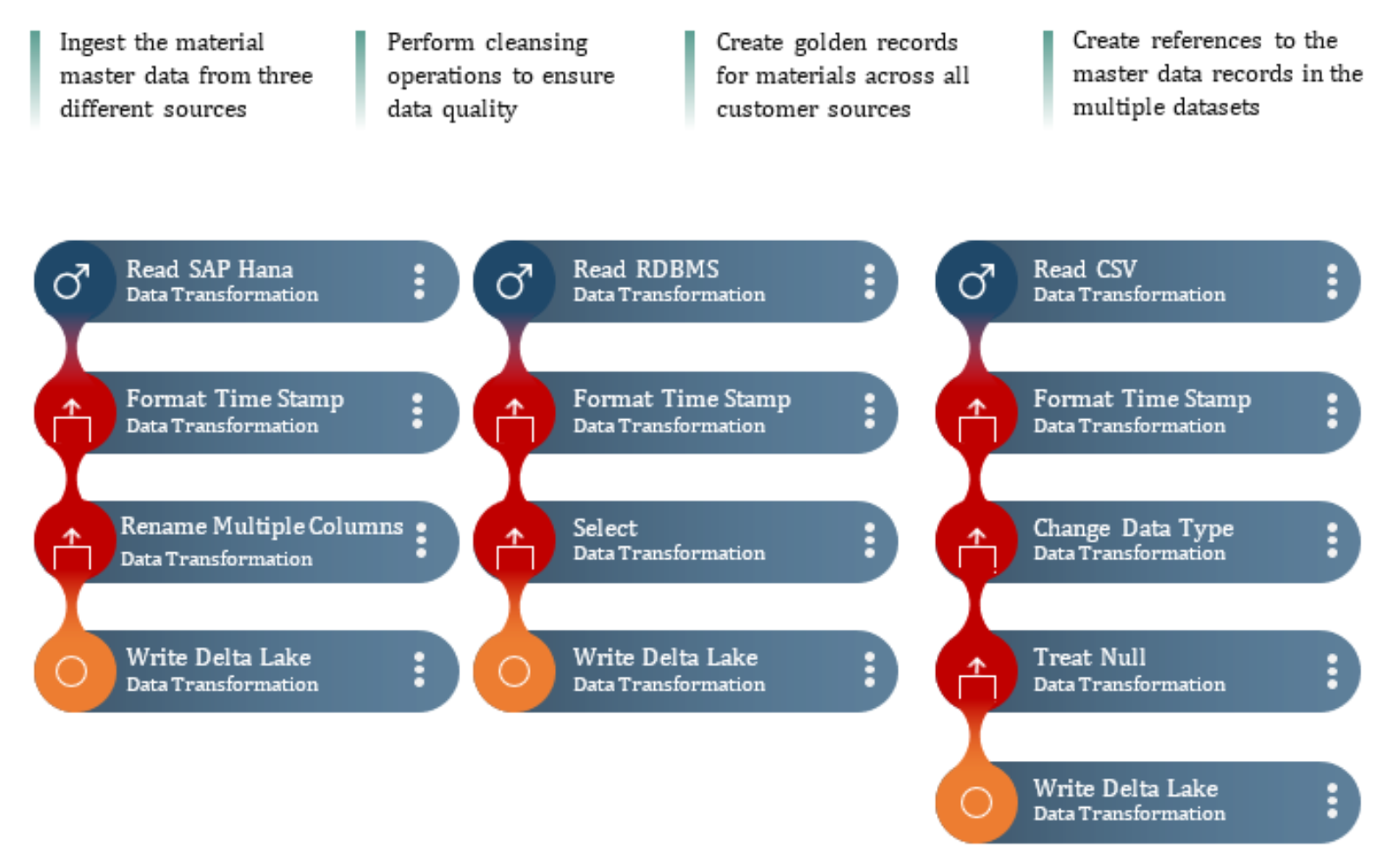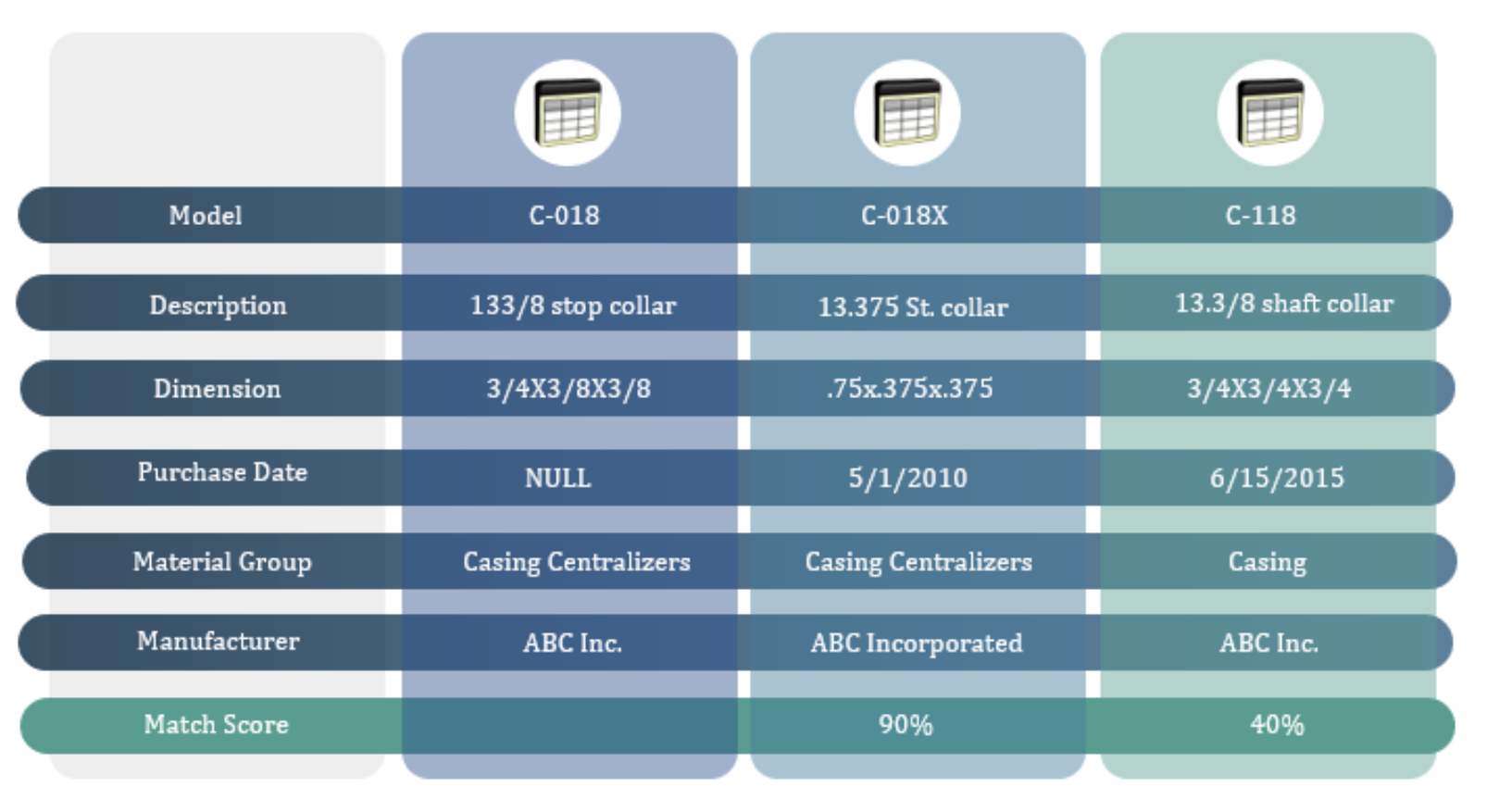How to Automate Data Reconciliation for Large, Multi-Variate Data Sets
Background
All data that a business needs is seldom from a single source. Different data sources might capture different facets
or attributes pertaining to a particular entity as shown in Figure 1. Some of the common attributes between sources
might also present conflicting information about the entity. Consider an event related to catastrophic equipment
failure for an industrial company. Information about this failure might be recorded in a variety of databases. For
example, the maintenance database might record information such as the date of failure, root cause and preventive
actions taken to address the failure, while a different safety events database might record the injuries, personnel
involved, compensation paid and other safety-related meta data.

Frequently, disparate data sources do not have unique identifiers that map events or entities between them. That
is, the failure event might have two different identifiers in the maintenance and safety databases. As a result, it
becomes too difficult to answer questions like, “what is the true cost of the equipment failure that caused the injury?
Most companies do not have the resources and budget to generate a common schema for enterprise entities which
could cater to multiple departments including operations, finance, marketing, accounts, etc. IT departments may
make an attempt to do so, oftentimes unsuccessfully. This is because implementing an enterprise Master Data
Management (MDM) systems can be very expensive and involves significant manual work. The complexity of the
project goes up exponentially if IT has inherited several disparate systems through past mergers and acquisitions. To
this end, a common need of industrial data users is to integrate data from multiple databases, where data pertaining
to the same entities is collected from various sources, reconcile conflicting information and aggregate
complementary information.
Traditional Approach
The enterprise data integration and reconciliation task typically involves multiple steps as shown below

In the IT world, this process is often called data mastering, and solved using software such as Informatica MDM. The
master data collects data from various sources and identifies identical or similar data and creates a database which
becomes the single source of truth.
This whole process involves significant manual work and is usually performed by a data expert using software. This
manual process is also custom based, i.e. it greatly depends on the data sources and hence, needs to be altered as
the sources change. Also, when the data includes geospatial components and text, which is not in the same format
in all sources, the process becomes even more difficult.
The DeepIQ Approach
DeepIQ has developed patent pending, AI based automated data reconciliation software that uses the power of
distributed computation and machine learning to automate the process of master data discovery.
DeepIQ’s software uses a combination of statistical and machine learning algorithms to achieve a high-quality data
mastering process. First, a series of statistical algorithms process all the sources to identify all versions of an entity
or event across sources. Next, the machine learning algorithms refine the output of statistical algorithm to prune out
poor quality results and generate high fidelity mapping of sources to globally unique entities. A final prioritization or
fusion approach amalgamates all sources to create golden records of each unique entity.
These sequences of algorithms can be very computationally intensive. Consider for example, creating a material
master for a combination of two sources, each with a million records. A naïve implementation to identify the unique
entities in the union of the two sources would require a trillion computations, where each entity in a source is
compared to every entity in another source.

Figure 2: Comparisons of millions of records
DeepIQ uses two strategies to handle this computationally intensive task. First, it runs natively on a distributed
computational platform that supports Apache Spark. Based on these techniques, DeepIQ’s software is able to run the
end-to-end master data workflows in just a few minutes even dealing with sources with multiple millions of entities.
DeepIQ’s DataStudio provides an easy to use, drag and drop interface for the relational ingestion and data
preparation like fixing time zones and filtering. DataStudio enables the user to create simple workflows for Master
Data
The Spark code is generated from a combination of the user generated workflows and the DeepIQ libraries. This
code is passed to Spark execution.
Success Story
An E&P company has grown through mergers and acquisitions. As a result, it has multiple data sources from different
organizations within the company containing information on all of the materials that it procures, stores and uses.
The original material master was no longer complete, and all downstream applications suffered from duplicate
material records, conflicting material configuration data and incorrect stock estimates.
The company decided to drive optimal processes in purchasing and inventory management to minimize stock outages
or unnecessary purchases. A traditional master data management solution would have taken more than a year to
complete with multiple people and several technology stacks. The company conducted a pilot with a leading vendor
that used a machine learning process to automate this task. The software license costs alone were in excess of $1
million per year and yielded mixed results at best.
At this point, the company started an engagement with DeepIQ to automate this process and achieve immediate
results. DeepIQ installed its DataStudio software and configured it to run on customer’s existing infrastructure.
Within four weeks, using DataStudio, our client configured the workflow to:

The solution was designed so that as new records were created, updated or deleted in the source systems, the master
data was updated. Processing all three data sources, including deduplication of the data within each source, took
only 12 minutes to complete on a medium sized cluster.
To ensure data quality, any records deemed to be between 75% to 90% match were sent to a human data steward
for verification. Random matches were also sent to the data steward. The decisions made by the data steward were
used to further train the master data model enabling the matching algorithm to improve over time.
The following diagram shows a sample of a typical match and the results

Conclusions
DeepIQ’s patent pending Master Data capability captures the complex interactions between different data entities
even when the training data is sparse. This unique capability can be a gamechanger for your enterprise data, allowing
users to more robustly analyse their business using the full scope of their dataset.
